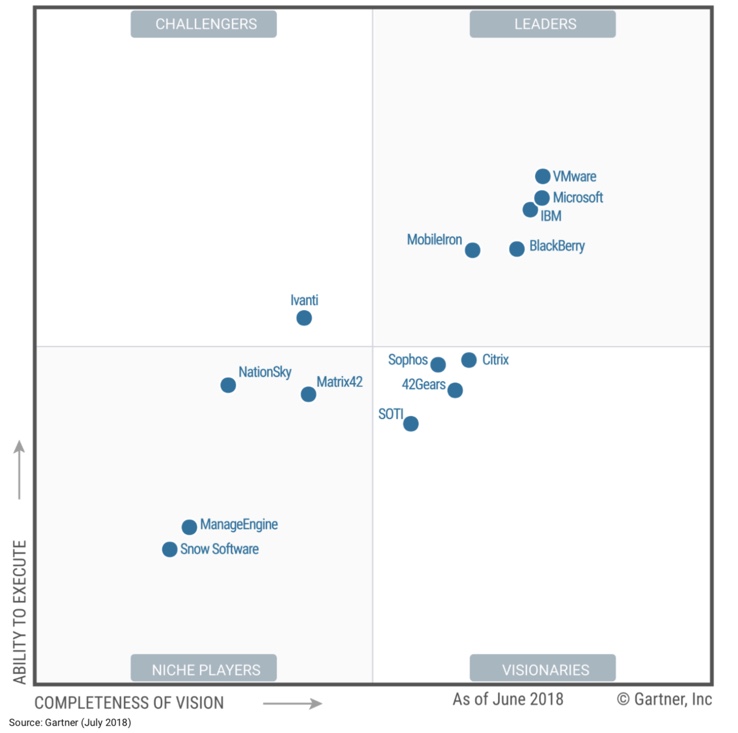Since the first ‘mobility’ Magic Quadrant (MQ) released by Gartner, we have seen different definitions, names and acronyms. Aside the strong consolidation in the sector and the changing name of the MQ, the core vendors remain the same, a demonstration how fast this mobile industry is evolving and how mobile is actually dominating IT; Mobile Device Management started out as a niche activity that was quickly rebranded to Enterprise Mobility Management. Today we talk about Unified Endpoint Management, it covers the management of multiple endpoint types in a single console, not necessarily mobile, and includes Windows 10 and macOS.

The way the different actors are positioned in the Magic Quadrant is based on their respective scores on two axes:
- Completenes of vision, how visionary is the vendor or how likely will it have future success in this market. It’s not only scoring the innovation of the technology (highest weight in the scoring) but also the overall strategy covering sales, marketing, product, market understanding AND the business model.
- Ability to execute, how well is the vendor meeting the customer expectations. What is the service quality, does the product or service meets the customer expectation, is the price/value relation acceptable. The scoring is based on actual customer interviews performed by Gartner.
When Gartner builds such an extensive report it takes a global view, that’s a good thing, but markets are different in EU, China and US and so are some of the vendors’ business models. In US most vendors tend to go direct to Enterprise customers, while EU is typically serviced through local partners.
On-premise implementations are compared with cloud only vendors. Without going into strategic debates, it’s just wrong to include both into the same overview. Clearly the control by the vendor over a cloud only offering is far bigger compared to on-premise installations. But on-premise provides the customer much more control over upgrades and data security, it’s a different product.
Given the continuously larger scope of technology included in the report, coming from mobile devices and now including any endpoint, there is an advantage for legacy big-portfolio vendors. The bigger the portfolio, the more (commercial or technical) products are bundled, the better. And that’s not necessarily to the benefit of the customer. The business world is not one-vendor, the most popular apps you run on your mobile devices are not owned by the manufacturer of your device, the same is true for business.
In my opinion we should look for more niche technology aces with extremely powerful interfaces, rather than technology giants offering ‘everything’. In fact, and for the first time in the MQ’s history, one could question if it’s really the most outright on the scale that is the most innovative, it’s certainly offering the most complete portfolio but could – at the same time – be the most ‘closed’ offering that is just the opposite of future-proof.
In conclusion, we see vendors ‘drifting’ around in the leaders quadrant and the differences are in the details of feature implementation dictated by Apple, Google and Microsoft to manage their OS. There is no ‘bad’ management platform in the leaders quadrant. More interesting are the differences in types of implementation (on-premise or cloud or both), how open the platforms can interface with other systems, speed of implementation when new device API’s become available and how well you can get serviced by your local partner. Important aspects that are not represented in the MQ.
